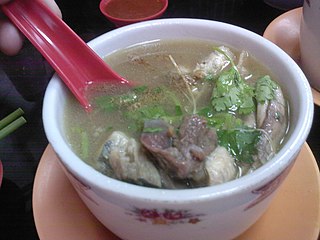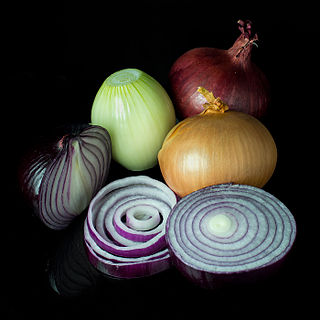Soup alla Canavese is an Italian soup made from white stock, tomato puree, butter, carrot, celery, onion, cauliflower, bacon fat, Parmesan cheese, parsley, sage, salt and pepper.

Tomato sauce can refer to a large number of different sauces made primarily from tomatoes, usually to be served as part of a dish, rather than as a condiment. Tomato sauces are common for meat and vegetables, but they are perhaps best known as bases for Mexican salsas or sauces for pasta dishes. Tomatoes have a rich flavor, high water content, soft flesh which breaks down easily, and the right composition to thicken into a sauce when they are cooked. All of these qualities make them ideal for simple and appealing sauces.

A mirepoix is a flavour base made from diced vegetables that are cooked, usually with butter, oil, or other fat, for a long time on a low heat without colour or browning. It is not sautéed or otherwise hard cooked because the intention is to sweeten the ingredients rather than caramelise them. It is a long-standing cooking technique in French cuisine. Further cooking, often with the addition of tomato purée, creates a darkened brown mixture called pincage.

Polish cuisine is a style of cooking and food preparation originating in or widely popular in Poland. Polish cuisine has evolved over the centuries to become very eclectic due to Poland's history and it shares many similarities with other West Slavic countries like neighbouring Czech and Slovak. It has also been widely influenced by other Central European cuisines, namely German, Austrian and Hungarian as well as Jewish, French, Turkish and Italian culinary traditions. Polish-styled cooking in other cultures is often referred to as à la polonaise.

Chicken tikka masala is a dish of chunks of roasted marinated chicken in a spiced curry sauce. The sauce is usually creamy and orange-coloured. There are multiple claims to its place of origin such as the Indian subcontinent and the United Kingdom. It is among the United Kingdom's most popular dishes.

A purée is cooked food, usually vegetables, fruits or legumes, that has been ground, pressed, blended or sieved to the consistency of a creamy paste or liquid. Purées of specific foods are often known by specific names, e.g., applesauce or hummus. The term is of French origin, where it meant in Old French purified or refined.

Tomato soup is a soup made with tomatoes as the primary ingredient. It may be served hot or cold in a bowl, and may be made in a variety of ways. It may be smooth in texture, and there are also recipes which include chunks of tomato, cream and chicken/vegetable stock. Popular toppings for tomato soup include sour cream or croutons. Tomato soup is one of the top comfort foods in Poland and the United States. It can be made fresh by blanching tomatoes, removing the skins, then blending them into a puree.

Kadhi or karhi is a dish originating from the Indian subcontinent. It consists of a thick gravy based on chickpea flour, and contains vegetable fritters called pakoras, to which dahi (yogurt) is added to give it a bit of sour taste. It is often eaten with boiled rice or roti.
A mechanical soft diet or edentulous diet is a diet that involves only foods that are physically soft, with the goal of reducing or eliminating the need to chew the food. It is recommended for people who have difficulty chewing food, including people with some types of dysphagia, the loss of many or all teeth, surgery involving the jaw, mouth or gastrointestinal tract, and pain from recently adjusted dental braces.
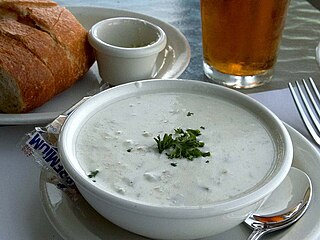
Fish soup is a food made by combining fish or seafood with vegetables and stock, juice, water, or another liquid. Hot soups are additionally characterized by boiling solid ingredients in liquids in a pot until the flavors are extracted, forming a broth.

Soup is a primarily liquid food, generally served warm or hot, that is made by combining ingredients of meat or vegetables with stock, or water. Hot soups are additionally characterized by boiling solid ingredients in liquids in a pot until the flavors are extracted, forming a broth.

Pea soup or split pea soup is soup made typically from dried peas, such as the split pea. It is, with variations, a part of the cuisine of many cultures. It is most often greyish-green or yellow in color depending on the regional variety of peas used; all are cultivars of Pisum sativum.
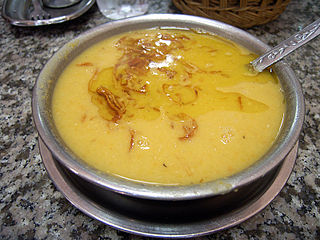
Lentil soup is a soup based on lentils; it may be vegetarian or include meat, and may use brown, red, yellow or black lentils, with or without the husk. Dehulled yellow and red lentils disintegrate in cooking, making a thick soup.
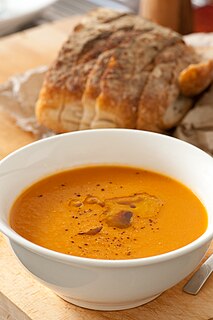
Carrot soup is a soup prepared with carrot as a primary ingredient. It can be prepared as a cream- or broth-style soup. Additional vegetables, root vegetables and various other ingredients can be used in its preparation. It may be served hot or cold, and several recipes exist.

Watercress soup is a soup prepared using the leaf vegetable watercress as a primary ingredient. It may be prepared as a cream soup or as a broth/stock-based soup using vegetable or chicken stock. Additional ingredients used can include vegetables such as potato, leeks, spinach, celery and turnips, cheese, butter, lemon juice, salt and pepper. Watercress soup can be prepared as a puréed soup by mixing the ingredients in a food processor. It can be served hot or cold, and may be garnished with crème fraîche, shaved Parmesan cheese, drizzled olive oil and watercress leaves.

